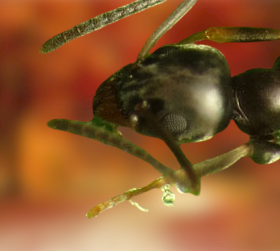The name “odorous house ant” comes from the pungent odor, similar to that of rotting coconut, that is released when these ants are crushed. Odorous house ants are capable of developing exceedingly big colonies, although they more commonly keep their colonies to a manageable size of several thousand workers and multiple queens. They have a strong preference for sugary foods, but they also consume grease and dead insects.
Although the nests of these Odorous House Ants are normally found outdoors under rocks, boards, and other similar objects, these ants are also reported to nest indoors as well. Colonies range in size from hundreds to thousands of people. These ants don’t attack other ants around their colonies; instead, they work together to conquer the regions they enter. These ants also known as sugar ants, like to build their nests outside and subsist on the honeydew that is produced by mealybugs and aphids. When the rain washes away plant honeydew, they attack homes more often.
Odorous House Ants Bite
The odorous house ant does not possess the ability to bite or sting, but it contaminates food as it searches for food in high numbers indoors. Because of their voracious appetites, they often come into confrontation with humans when they contaminate food supplies kept in closets.
Eliminating odorous house ants is a time-consuming process because of the large size of their colonies. When scout ants travel to a new location in search of food, they bring back with them an invisible scent trail that leads back to their colony. Homes are invaded by worker ants in huge numbers when they follow a scent trail to a food source within a building or home.
Odorous House Ants Size
This tiny ant, which measures just about 1/8 of an inch in length, is particularly fond of sugary foods like fruit juices and baked goods, though it eats a wide range of other things as well. It is capable of building a nest anywhere, even inside of buildings under insulation, walls, window frames, or under stones, mulch, logs, or other trash.
Workers are uniform in size and color, measuring between 1/8 and 3/16 of an inch in length and ranging in color from black to brown. A flattened node is seen in one section of the waist (pedicel), but this makes it very difficult to pinpoint. Colonies of odorous house ants range in size from 2,000 to 5,000 individuals. Honeydew is their primary source of nutrition, and they care for insects that excrete honeydew in the field. However, many of these insects also hunt for food and are drawn to sugary and fatty foods.
Odorous House Ants Wings
The odorous house ant is a very little insect, but it moves extremely fast. They travel in lines most of the time, but if they are startled or worried, they often scatter and run haphazardly, releasing their smell as they move. Although the smell of rotting coconuts is the most common association, some people also described it as being similar to a peculiar pine scent.
These little ants’ unpleasant odor is not their only distinguishing feature. They also change locations so frequently. There are odorous house ants that do briefly develop wings. Depending on the region, these ants usually swarm in the spring or early summer months to reproduce.
Odorous House Ants vs Sugar Ants
Sugar ants and odorous ants share several similar qualities; however, odorous ants are often smaller, and the biggest distinguishing feature about them is their odor. When common house ants are squashed, many people detect their odor. The odor resembles blue cheese or rotting coconut. In contrast, sugar ants are huge ants that are primarily orange-brown in the center and black on the head and abdomen.
The Sugar Ant gets its name from their fondness for sugar, however, they are drawn to any sweet meal. They consume both plant and animal matter, and during the warmer months of the year, it is possible to spot them foraging for food under house lights or on the streets. The odorous house ant, on the other hand, gets its name from the pungent odor it emits when crushed, which is similar to that of rotting coconut.



